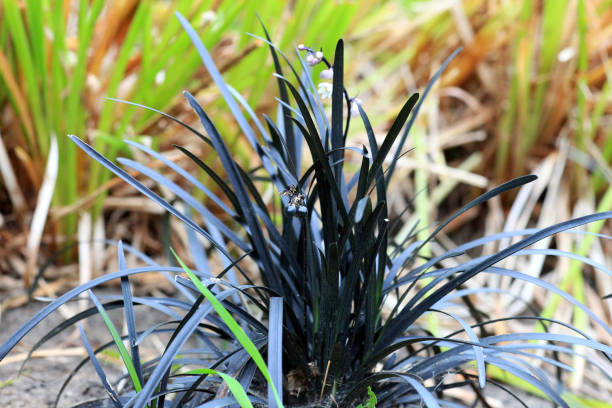Mondo grass is a great addition to any garden. This grass kind is tough, sturdy, and tolerant to all kinds of weather. Everything you need to know is right here.
The grass only need water to survive, and it is resistant to pests such as deer. Planting mondo grass in a shaded place is not a problem because the roots grow quickly and can be found in shady regions of the garden.
Mondo grass is low-maintenance and will thrive all year under the right conditions. Line flowerbeds with mondo grass to give your yard a more dimensional and groomed appearance.
RELATED The Benefits of a Square Garden and How to Build Your Own
Mondo Grass varieties.
In your garden, there are three main forms of mondograss. Before you go to the nursery and start planting in your garden, have a look at the features of the three mondograss species to see which one will work best for you.
Mondo Grass, Black.

This mondo grass gives your yard an attractive appearance that your visitors will appreciate. This grass is darker in colour than your lawn’s conventional brilliant or light-green tones.
Because it grows from stolons beneath the ground’s surface, this cultivar grows slowly. Black mondograss grows well in sunny sections of the garden, although it can also be found in shadier areas.
This type is thirsty, so you’ll need to water it frequently to keep it growing. Black mondo grass is attractive as a flowerbed addition because of its dark foliage. It grows to a height of 10 inches and flowers in the summer.
The grass starts off light green, but as the growing season progresses, it turns black. This mondograss species is resistant to the cold and will thrive throughout the winter months.
Also Read: What is a good lawn care schedule?
Mondo Grass for Dwarves.
This customised mondo grass only reaches two to four inches in height. The plant’s leaves are narrow, and it has a delicate appearance that makes it ideal for use as ground cover in flowerbeds. Cold temperatures and bugs are not a problem for dwarf mondo grass.
Japonicus Ophiopogon.
This is the most popular mondo grass cultivar seen in gardens across the United States. Ophiopogon Japonicus grows to a height of six to ten inches on average, although under the appropriate conditions, some grasses can reach a height of twelve inches.
These plants grow to be rather large, with a circumference of up to 15 inches. This cultivar is also resistant to pests and weather, and it thrives in shady sections of the garden.
Mondo Grass Growing Conditions.
Every gardener’s fantasy is Mondograss. The plants are low-maintenance, which makes them perfect for growing in difficult-to-reach sections of the yard, such as on hills. The plants also thrive in the shade of trees, and they continue to thrive even when they are not exposed to direct sunshine.
Mondo grass thrives in USDA zones 7 through 11. Because of the grass’s hardiness, it is drought resistant, making it a good choice for gardeners who are currently working with water limitations.
Mondo Grass Maintenance.
Mondo grass requires little maintenance during the growth season, making it an excellent choice for gardeners who want low-maintenance plants.
To keep this grass looking fantastic, all you have to do is water it occasionally during hot weather and pull weeds from the flowerbeds. You’ll need to dig up the grass and separate the root clumps every two or three years.
Mondo Grass Planting and Propagation.
Mondo grass is simple to grow and propagate. Seeds can be purchased from a local nursery, or you can cultivate starter plants with established root systems. The most difficult task for any mondo grass planter is keeping weeds at bay. Mulching around plants or laying straw over the ground to prevent sunlight is the greatest technique to keep weeds at bay.
Plant mondograss in the early spring after the final frosts have passed. Planting later in the growth season is also possible, as long as the grass has had enough time to create a strong root system.
You can put your mondo grass wherever you want. It’s best used in shaded regions of the garden where the earth appears scant. You can also utilise dwarf types to line flowerbeds, offering natural insect protection for your blooms.
If you’re going to plant your mondo grass in a sunny spot in the yard, make sure to thoroughly hydrate the roots to avoid transplant shock. Prepare your flowerbed by loosening the soil by digging for at least 18 inches.
This method enhances soil drainage and aeration for the roots of the plant. To hasten the growth of your plants, add some compost to the soil. For the greatest growing circumstances, Mondo grass prefers slightly acidic soil.
Before planting, make a note of the depth of the roots in the cell pack and try to put your grass at the same height. Plant your grass at least four to six inches apart, with a spacing of eight to ten inches being ideal.
Mondo grass doesn’t require much in the way of nutrients to thrive, and for the first few years, you can get away with just one feeding in the early spring. The grass will not require any additional fertiliser treatments after it has established itself.
Lawns made from Mondo Grass.

Mondo grass is a plant that can be used in a variety of ways. It can be used to add dimension to your garden designs or to brighten up your flowerbeds. You can use it on your lawn in sparse spots to fill in the gaps because the grass is resistant to climate change. If you reside in a desert area like Nevada, mondo grass is an excellent lawn replacement option.
Diseases & Pests that Affect Mondo Grass.
It’s possible that your mondo grass is suffering from root rot if you see discolouration. While mondo grass is resistant to many pests and diseases, root rot will develop in all kinds if the roots are left in poorly draining soil.
Mondo grass dislikes having its “feet wet,” and if the roots are in continual touch with a water source, they will begin to rot.
Root rot symptoms – Gardeners can spot root rot by looking for telltale indicators. You may detect leaf-tip burn on your plants, which causes the grass blades to develop a yellow or brownish tint.
Treating Mondo Grass Root Rot — To effectively treat root rot, you’ll need to employ a fungicide. Pythium splendens, which causes root rot in your plants, can be controlled with biological fungicides including Gliocladium virens strain GL-21.
Dilute the fungicide in a gallon of water at a third of an ounce per gallon. This quantity and ration should be sufficient to treat 10-square feet of plants. Wait till the weather is dry before spraying the fungal solution all over the grass.
Mulching fertiliser into the roots of your plants might also assist to prevent root rot. Compost contains microorganisms that fight invading infections and bring the roots back to full health.
To a depth of about 1 inch, work the compost into the earth around the base of the grass. Over the course of a month, your grass should gradually recover. If the condition worsens, though, you may have to pluck the grass. These diseases also overwinter in the soil, wreaking havoc on any adjacent plants.
Mondo Grass Shouldn’t Be Overwatered.
Root formation in your mondo grass can happen for a variety of reasons. The most prevalent cause of root rot, on the other hand, is a combination of overwatering and poor soil drainage. If you don’t let the roots dry out completely between watering sessions, mondo grass will start to develop root rot.
Water saving measures. Poster pictures and slogan lines. for kids projects
Controlling pests.
Your mondo grass is a favourite of snails and slugs. If they start attacking your plants, you’ll see the grass starting to die. The pests eat the grass, causing the leaves to droop.
Snail and slug bait, which may be purchased at your local nursery, can help to limit the damage. Snails and slugs love to emerge after it rains, so keep an eye out for them.
Showers and heavy rains are expected.

After a rainy time, separate the leaves of your mondo grass to hunt for slugs and snails. Before placing the bait around the base of the plant, remove any visible slugs and snails.
There’s no need to be concerned about the pesticide damaging your other plants or the wildlife in the area. The toxin in the bait is only active when it comes into contact with water.
Feeding sessions should be repeated.
Snail bait granules contain ferric phosphate, which is safe for your pets and birds visiting your garden. When the snails come into contact with the bait, they stop eating your grass. Place the bait granules about 3-inches apart, and keep an eye out for evidence of snails and slugs over the next few days.
Finally, some final thoughts.
Read Also: Top 5 Reasons to Subscribe to Homes and Gardens Magazine Today
Mondo grass is a terrific alternative to your garden’s turf. This evergreen grass looks great all year and requires very little maintenance to keep it fresh. The plant’s sluggish growth making it great for training and rerouting to different locations of your garden

